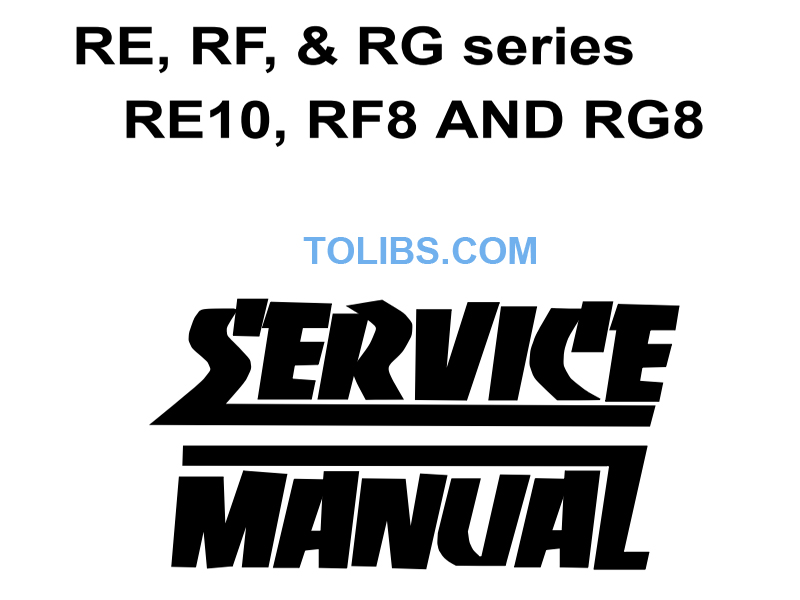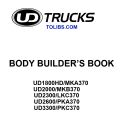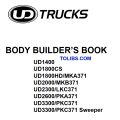UD TRUCKS Engine RE, RF, RG Service Manual

UD TRUCKS Engine RE, RF, & RG series RE10, RF8 AND RG8 Service Repair Manual
GENERAL REMARKS REGARDING DISASSEMBLY OPERATIONS
Establishing conditions prior to disassembly Before starting to disassemble, check the nature of the problem to see if disassembly is really required. For example, if the problem is in the engine, is there any abnormal noise? insufficient output? oil leakage? As a result of disassembly and inspection, the cause of the trouble can be accurately determined.
Disassembly
When disassembling complicated assemblies, stamp parts that have no effect on the assembly functional and use matching marks in order to make reassembly easier. Also, when repairing the electrical system, be sure to remove the cable from the negative terminal of the battery first.
Inspection during disassembly
Each time you remove a part, inspect that part for correct assembly, cleanliness, wear, damage and so on. High efficiency cannot be obtained if all parts are disassembled prior to inspection.
Arrangement of disassembled parts
After disassembly, lay the parts down in the proper order so they will not get mixed up. Replace all packing materials, gaskets, split pins and so on with new ones. Make sure your hands are clean before handling V-belts, rubber items and electrical components that are sensitive to water and oil. Place these parts in a different location from components that are covered with engine oil.
PREPARATION
When doing maintenance work on each section of the engine, the following points should be strictly observed:
- Park the vehicle in a level spot. If the area is not level, it will not be possible to perform oil inspections properly; it is also dangerous, since the vehicle may suddenly begin rolling down the incline.
- Set the parking brake to lock the wheels in place and chock both the front and rear wheels.
- Do not perform maintenance operations while the engine is still hot. Wait for it to cool first.
- Set the gearshift to neutral.
- Make sure the key is in the OFF position. When doing work on the electrical system, disconnect the battery cable from the negative terminal of the battery as well.
- When starting the engine to perform maintenance operations, be particularly careful not to touch any of the rotating parts. Also, make sure the area is well-ventilated when running the engine.
Cleaning disassembled parts
Clean or wash all parts before starting reassembly. If disassembled parts are not cleaned before reassembly, it will be impossible to judge which parts are good and which are bad and discover part defects. In addition, foreign matter may adhere to the parts during reassembly and contaminate the engine, adversely affecting performance and possibly leading to engine trouble. Be sure to maintain the proper degree of cleanliness during repair operations.
Reassembly
During reassembly, be sure to use the right procedure to assemble the right part with the right standard (tightening torque, adjustment value, etc.). Also, do not forget to apply oil or grease where required.
Adjustment and operation check
Adjust parts to the specified standard value, using a gauge or tester. Ultimately it would be most efficient to operate or perform an inspection each time the assembly operation is performed.
CLEANING AND INSPECTION
Each component part must be cleaned of dirty oil, oil sludges, scale, carbon, old gasket or adhesives attached to it. Cleaning methods are: high temperature steam cleaning, light oil cleaning, acid or alkaline solution cleaning, neutral detergent cleaning, trichlene solution steam cleaning, and magnas fluid cleaning. In cleaning, unexpected crack or damage may often be found. It is important, therefore, to take sufficient care during cleaning not to overlook any defect on a part.
Cleaning metal parts
Cleaning with light oil:
Light oil features minimal permeability and solubility for matter adhered to the surface of the parts, and is therefore most suitable for cleaning parts with sliding surfaces or finely finished surfaces. For other portions, use a wire brush, a wooden spatula, or a piece of metal plate to scrape off foreign matter. Perform this preliminary cleaning before conducting final cleaning.
Cleaning with alkaline fluid:
For those parts composed of a single kind of material such as copper, cast iron, and aluminum, alkaline cleaning fluid may be used. However, for a metal product composed of two or more materials, such as bearing shell and bushing, cleaning with light oil, trichlene solvent, steam, or magnas fluid is recommended, because electrolytic corrosion may occur due to ionization in these type parts.
Cleaning rubber products:
When cleaning rubber parts, use alcohol to remove foreign matter. Never use light oil, lamp oil or any other mineral oil.
Cleaning oil line
Pass a wire through the oil line in each part to make sure the line is not clogged, then squirt cleaning fluid from the nozzle to clean.
Rustproofing
When parts have been cleaned and the grease has been completely removed, coat the surfaces with clean oil to prevent the part from rusting.
INSPECTION
- During inspection, use measuring instruments in accordance with the maintenance standards and make pass/fail determinations accurately. When the values exceed the repair limit or wear limit, be sure to repair the part or replace it with a new one. When the standards for determining whether or not the part should be replaced are shown by clearances, replace the corresponding part or the whole of the assembly as needed.
- Even if the measured values are within the wear limit, in some cases it would be better to replace the part from the standpoint of preventive maintenance.
- When inspecting parts, be sure to check the external appearance as well, either through visual inspection, ‘red check‘ or the like. When the problems listed below are observed in an external appearance check, the part should be repaired or replaced.
If even one of the following damages is noted during inspection, be sure to repair or replace the corresponding part with a new one. In addition, note that, in principle, all rubber parts such as O-rings, oil seals and the like should be replaced with new ones.












